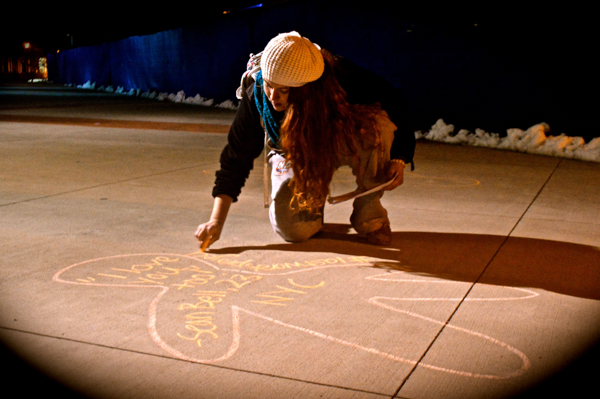
In light of the recent deaths of unarmed Eric Garner, 43, and Michael Brown, 18, the SUNY New Paltz community has come together more than it ever has before, and all for a good, common cause.
On Nov. 24 and 25, New Paltz students came together to take action in their student-run movement entitled, “NPWakesUp.”
Inspired by the activism of her fellow students, third-year secondary adolescence education major and former Student Association (SA) Sen. Caitlin O’Connor decided she would take action in her own way.
On the night of Thursday, Dec. 4, O’Connor and her fellow SA colleagues — second-year journalism and political science major Sarah Eames, and fourth-year political science major James Auer — chalked the SUNY New Paltz academic concourse with outlines of bodies as well as the last words of those who have been killed because of police brutality.
“I feel it was important to highlight the lives of men and people of color killed by police, past and present,” O’Connor said.
She said that while researching the cases of Garner and Brown, she came across 30 other names who had been killed by policemen within the past 15 years.
One story that stood out to O’Connor in particular was that of 16-year-old Kimani Gray, who had been shot to death by police officers in March of 2013.
O’Connor said Gray’s last words of, “Please don’t let me die,” were easily the most affecting for her and had only solidified her cause even further.
“My thoughts on all of these instances are that there is a common denominator here when it comes to the killing of men of color by police and that is the ‘us versus them’ mentality,” O’Connor said. “There is no cohesiveness.”
She said she was also inspired by the work of Shirin Barghi, an Irani artist who portrayed the deaths of unarmed men killed by police through a series of prints with their names, ages, dates that they were killed and their last words.
“I wanted to bring these bodies to life again, through their humanity,” O’Connor said. “Nothing is more telling and human and finite than the last breath we take. This is an evident pattern, a systematic failure — not one instance of interaction between man and law enforcement.”
